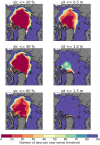Future sea ice conditions and weather forecasts in the Arctic: Implications for Arctic shipping
- PMID: 29080010
- PMCID: PMC5673867
- DOI: 10.1007/s13280-017-0951-5
Future sea ice conditions and weather forecasts in the Arctic: Implications for Arctic shipping
Abstract
The ability to forecast sea ice (both extent and thickness) and weather conditions are the major factors when it comes to safe marine transportation in the Arctic Ocean. This paper presents findings focusing on sea ice and weather prediction in the Arctic Ocean for navigation purposes, in particular along the Northeast Passage. Based on comparison with the observed sea ice concentrations for validation, the best performing Earth system models from the Intergovernmental Panel on Climate Change (IPCC) program (CMIP5-Coupled Model Intercomparison Project phase 5) were selected to provide ranges of potential future sea ice conditions. Our results showed that, despite a general tendency toward less sea ice cover in summer, internal variability will still be large and shipping along the Northeast Passage might still be hampered by sea ice blocking narrow passages. This will make sea ice forecasts on shorter time and space scales and Arctic weather prediction even more important.
Keywords: Climate change; Polar shipping; Sea ice; Weather forecast.
Figures








Similar articles
-
Additional Arctic observations improve weather and sea-ice forecasts for the Northern Sea Route.Sci Rep. 2015 Nov 20;5:16868. doi: 10.1038/srep16868. Sci Rep. 2015. PMID: 26585690 Free PMC article.
-
Arctic sea ice and climate change--will the ice disappear in this century?Sci Prog. 2000;83 ( Pt 3):209-22. Sci Prog. 2000. PMID: 11077477
-
ARCTIC CHANGE AND POSSIBLE INFLUENCE ON MID-LATITUDE CLIMATE AND WEATHER: A US CLIVAR White Paper.US CLIVAR Rep. 2018 Mar;n/a:10.5065/D6TH8KGW. doi: 10.5065/D6TH8KGW. US CLIVAR Rep. 2018. PMID: 31633127 Free PMC article.
-
The Arctic's sea ice cover: trends, variability, predictability, and comparisons to the Antarctic.Ann N Y Acad Sci. 2019 Jan;1436(1):36-53. doi: 10.1111/nyas.13856. Epub 2018 May 28. Ann N Y Acad Sci. 2019. PMID: 29806697 Review.
-
Loss of sea ice in the Arctic.Ann Rev Mar Sci. 2009;1:417-41. doi: 10.1146/annurev.marine.010908.163805. Ann Rev Mar Sci. 2009. PMID: 21141043 Review.
Cited by
-
Arctic Climate Change, Economy and Society (ACCESS): Integrated perspectives.Ambio. 2017 Dec;46(Suppl 3):341-354. doi: 10.1007/s13280-017-0953-3. Ambio. 2017. PMID: 29067642 Free PMC article.
-
Spatial and temporal variability in ringed seal (Pusa hispida) stable isotopes in the Beaufort Sea.Ecol Evol. 2020 Mar 24;10(10):4178-4192. doi: 10.1002/ece3.6186. eCollection 2020 May. Ecol Evol. 2020. PMID: 32489588 Free PMC article.
References
-
- Andersson, E., and Y. Sato. (ed.). 2012. Report from fifth WMO Workshop on the impact of various observing systems on NWP. WMO Integrated Observing system Technical Report no 2-2012. http://www.wmo.int/pages/prog/www/OSY/Meetings/NWP5_Sedona2012/Final_Rep... .
-
- Bengtsson L, Andrae U, Aspelien T, Batrak Y, Calvo J, de Rooy W, Gleeson E, Hansen-Sass B, et al. The HARMONIE-AROME model configuration in the ALADIN-HIRLAM NWP system. Monthly Weather Review. 2017;145:1919–1935. doi: 10.1175/MWR-D-16-0417.1. - DOI
-
- Castro-Morales K, Kauker F, Losch M, Hendricks S, Riemann-Campe K, Gerdes R. Sensitivity of simulated Arctic sea ice to realistic ice thickness distributions and snow parameterizations. Journal of Geophysical Research: Oceans. 2014;119(1):559–571. doi: 10.1002/2013jc009342. - DOI
-
- Dee DP, Uppala SM, Simmons AJ, Berrisford P, Poli P, Kobayashi S, Andrae U, Balmaseda MA, et al. The ERA-Interim reanalysis: configuration and performance of the data assimilation system. Quarterly Journal of the Royal Meteorological Society. 2011;137:553–597. doi: 10.1002/qj.828. - DOI
-
- Emmerson, C., and G. Lahn. 2012. Arctic opening: Opportunity and Risk in the High North. Report from Lloyd’s and Chatham House 2012. https://www.chathamhouse.org/sites/files/chathamhouse/public/Research/En....
MeSH terms
LinkOut - more resources
Full Text Sources
Other Literature Sources
Medical
Molecular Biology Databases

